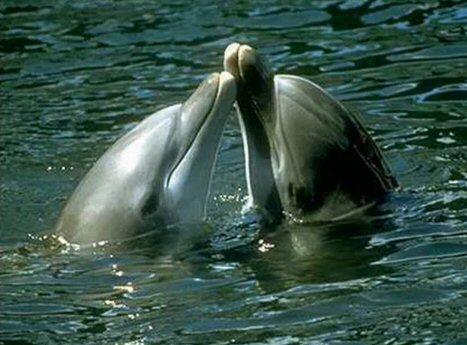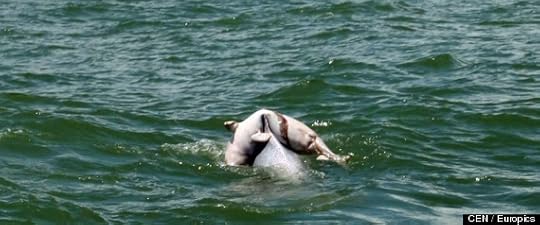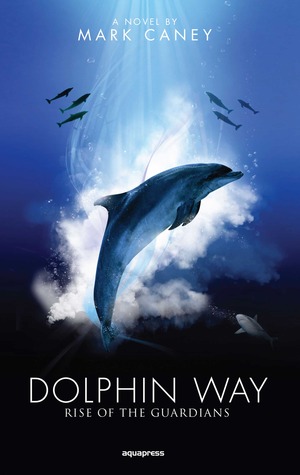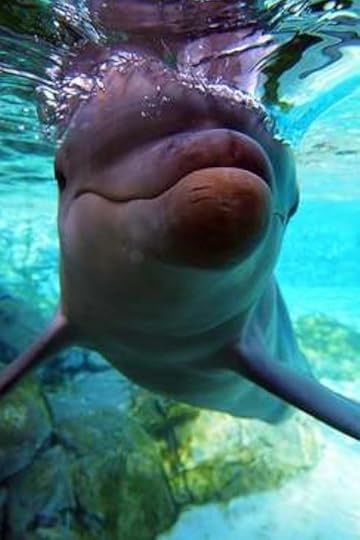Mark Caney's Blog, page 46
July 20, 2012
Dolphins can do nonlinear math, new sonar study suggests
 Math-challenged, beware: dolphins may be better at complex nonlinear mathematics than you are, reported Discovery News.
Math-challenged, beware: dolphins may be better at complex nonlinear mathematics than you are, reported Discovery News.
We’ve always known that dolphins are unnervingly intelligent. Now, a study has revealed that dolphins may be using complex mathematics when using their built-in sonar to hunt for food.
A paper published in the Royal Society of A Journal concluded that dolphin’s sonar abilities may be bolstered by the animal’s ability to benefit from nonlinear mathematics. These functions include addition, subtraction, multiplication and the calculation of ratios, says Discovery News.
Lead author Timothy Leighton of the University of Southampton’s Institute of Sound and Vibration Research was inspired to carry out the study after watching an episode of Discovery’s Blue Planet documentary, Discovery News reported, where he realized even the best man-made sonar couldn’t operate correctly in the bubble nets dolphins create to confound prey.
“These dolphins were either ‘blinding’ their most spectacular sensory apparatus when hunting — which would be odd, though they still have sight to reply on — or they have a sonar that can do what human sonar cannot…Perhaps they have something amazing,” Leighton told Discovery News.
The answer to Leighton’s conundrum? Math – and not particularly simple math. The dolphins send out pulses that vary in amplitude, Discovery News reported, and the animals must perform a variety of calculations – including ratios and multiplication – so that they can “see” prey.
Although further tests need to be carried out before dolphin math skills can be fully confirmed, Discovery says, the study provides interesting insight in the possibilities of animal intelligence.
Full story: Global Post

July 18, 2012
Dolphin Carries Its Dead Baby Out To Sea

Tourists in China captured a poignant moment on camera recently when they saw an adult dolphin carrying its deceased calf out to sea.
In the photograph, the dolphin has mounted the baby’s limp body on its back and a large, bloody gash can be seen in the calf’s side. According to the Daily Mail, it appears the dolphin might have been hit by one of the tour boats that ferry around the well-known dolphin-watching area in China’s Guangxi Zhuang region.
“I have heard dolphin saves human, but it’s my first time to see such a scene,” a boatman familiar with the area told CEN/Europics.
According to the caption on the photo from CEN/Europics, the baby dolphin’s body slipped off and nearly sank several times, but the adult dolphin managed to retrieve the body.
The Mail notes that the scene raises the question of whether dolphins are aware of their own mortality, which has long been debated by researchers.
Researchers have observed, however, that dolphins do mourn and grieve for their dead.
This is just the latest account of a dolphin expressing compassion. In April, three men claimed that they were possibly saved from sharks by a pack of dolphins that ran them off.
Many studies have been focused on researching the traits and intelligence of dolphins. Neuroscientist Lori Marino told the Associated Press last month that although their brain looks different from a human’s, “the more you learn about them, the more you realize that they do have the capacity and characteristics that we think of when we think of a person.”
Unfortunately, this incident is not isolated. A study conducted by WWF in 2010 found that rare dolphins were being injured by boat strikes. Many dolphin species are threatened by fishing gear, pollution, and habitat loss.
Source: Huffington Post

July 17, 2012
July 16, 2012
Win a paperback copy of Dolphin Way
Goodreads Book Giveaway

Dolphin Way
by Mark Caney
Giveaway ends August 15, 2012.
See the giveaway details
at Goodreads.

July 14, 2012
Off-duty officer, fire chief rescue stranded dolphin in US
Fridrik Tiedemann doubts his grandson will ever forget the day Papa rescued a dolphin.
Tiedemann took Jackson White, 8, kayaking July 3 on Battery Creek. They spent the afternoon on a small tributary, watching crabs, fish and a dolphin play.
“We lost sight of her, and the next thing my grandson says is ‘Papa,’ Tiedemann said. “And I heard this splashing and flailing. ‘Papa, Papa, there’s the dolphin.’
“And the dolphin was on the sandbar and couldn’t get off.”
Tiedemann — a veteran law enforcement official who has worked with the S.C. Highway Patrol, the Beaufort County Sheriff’s Office and the Beaufort City Police Department — went into action.
He told his grandson to stand out of the way as he cautiously approached the dolphin, which was on its side.
“She settled down and I talked to her. Well, I don’t know how much she understood,” he said. “I just kept telling her, ‘You’ll be OK honey, you’ll be OK. We’ll get out of here.’ And the dolphin, she’s looking at me, she’s got her eyes just focused on me, and in that combination of her being tired and me talking to her, she didn’t object to me touching her.”
Tiedemann took the dolphin’s tail and started trying to drag it across the sandbar, which he estimated to be 100 feet wide.
That’s when a boat pulled up and Beaufort Fire Chief Clay Scoggins jumped out.
Scoggins said he was launching his boat from the Battery Creek Landing when people started shouting about the dolphin rescue. He offered a hand, and together the men dragged the dolphin into Battery Creek, where it promptly swam off, Scoggins said.
Full story: Herald Online

July 10, 2012
Fantasy Book Review Features Dolphin Way
The book review site, Fantasy Book Review, has just featured the video trailer for Dolphin Way: Rise of the Guardians.
Get the book

July 9, 2012
First ever Dolphin show in Karachi, Pakistan
The international dolphin show with the cooperation of Pakistan Navy will be held for the citizens of Karachi in October this year. This year, this was stated by Commander Karachi, Pakistan Navy Rear Admiral Khawja Ghazanfar Hussain SI (M) and Mr. Mustafa Kamal of TBI.
The Talent Broker International (TBI) with their international partners Utrish Dolphinarium Inc. are organizing Dolphin International Shows for the first time in Pakistan The official announcement of the launching of the dolphin shows and ground breaking ceremony of state-of-the-art swimming pool was made at the Maritime Museum Karsaz Karachi by Commander Karachi Pakistan Navy Rear Admiral, Chief Executive Officer of Utrish Dolphinarium Lev Mukhametov from Russia and Mr Mustafa Kamal of Talent Broker Intl. The 80 feet long and 50 feet wide swimming pool with a straight depth of 14 feet will be built conforming to international standards and requirement for dolphin show. Also, a big arena will be built with the seating capacity of around 4000 for the show.
Commander Karachi Rear Admiral Ghazafar Hussain said that considering the situation that there are limited entertainment opportunities in the country and no international entertainment event has been held for the last few years due to security issues, this first ever series of dolphin shows would be a moment of joy and fun for the citizens.
Mustafa Kamal CEO TBI said, this new form of entertainment to provide diversity from routine life will also be a great opportunity of learning obedience, grace, agility and softness of dolphins through their exciting performances in water for the people of every walk of life and to experience how dolphins communicate with humans. Dolphins’ live performance will thrill the audience through their amazing acrobatic ability, leaping high into the air performing bows and spins, dancing and rocket ride with the trainers and much more, he mentioned. Chief Executive Officer of Utrish Dolphinarium Lev Mukhametov said that a team of eight members of Utrish Dolphinarium Inc. comprising five performers, two handlers, and a doctor will be coming soon to Pakistan. They are bringing with them four bottlenose dolphins and two sea lions to conduct more than 160 shows in Karachi. Later, another team of 42 members of the company will arrive that will include performers, trainers, dolphin handlers and veterinary doctors.
Source: Pakistan Observer

July 6, 2012
New Dolphin Way book trailer video!
July 4, 2012
Will we ever learn to speak dolphin?
Dolphins are highly intelligent mammals, with an amazing ability to learn to understand our language. But as we gain more insights into their behaviour, we’re also coming to suspect that they might have their very own language — or at the very least a complex system for communicating with one another.
 A big question facing marine biologists today is whether we’ll ever be able to understand what they’re actually saying. Thankfully, science could help us to construct a dolphin Rosetta Stone — but it won’t be easy.
A big question facing marine biologists today is whether we’ll ever be able to understand what they’re actually saying. Thankfully, science could help us to construct a dolphin Rosetta Stone — but it won’t be easy.
Dolphins, like humans, devote a considerable portion of its genome to the development of the nervous system — a strong indication that their cognitive capacities are comparable to our own.
And like us, they have large brains and the capacity for higher-order thinking. They live in hierarchical arrangements, engage in fission-fusion social arrangements (which means dolphins come and go between pods as they please), cooperate, and exhibit unique personalities.
They can also pass the mirror test (an indication that they have a strong sense of self) and are able to respond to commands issued from a television monitor (surprisingly, not a lot of animals can do this — including some primates).
And as highly social and engaged mammals, they may also have similar communicative needs. We certainly know that they have the capacity to understand language, but what we don’t know is how much of their language is their own.
Clicks, burst-pulses, and whistles
Dolphins clearly have the means to communicate, and they do so with various sounds, including whistles, burst-pulses, and clicks. Just exactly what they’re saying with all these noises, however, remains a mystery — but after years of study, marine biologists are starting to get a sense.
And scientists believe the clicks are used for echolocation. This allows dolphins to examine their environment through sound, listening to the echoes returning from objects being struck by the clicks. They may also be used for communication, and marine biologists are studying them to understand if this is the case.
Burst-pulse sounds may indicate a dolphin’s emotional state, ranging from pleasure to anger — but we haven’t studied these types of vocalizations very thoroughly, and we still have a lot to learn about them.
And as for the whistles, people are still debating whether, or how much, of whistle communication is intentional as opposed to unintentional (vocalizing stress, for example). But one thing is becoming increasingly clear: The whistles may actually be the names of dolphins.
Signature whistles
Or at the very least, whistles may a way for dolphins to identify themselves. One person who is seriously considering this possibility is Princeton’s Tara Thean who has worked with the Sarasota Dolphin Research Program. Thean has spent time with bottlenose dolphins trying to get a better understanding of how they might be using their whistles to call out to each other and communicate.
Thean tells io9 that dolphins may be using their whistles as a means to identify one another. “They are basically stereotyped acoustic signals that identify the caller,” she says. “Dolphins acquire these distinctive whistles as early as one year old.” Exactly how these “signature whistles” emerge, however, remains a mystery.
Even after meticulous listening for weeks on end, Thean noted that the identification whistles were never random and always consistent. In fact, she listened to identification whistles dating back several years and a number of them remained exactly the same as the ones still used today.
Thean is curious to know how the dolphins acquire their signature whistles, and who in the group is responsible for creating them. To this end, Thean hopes to study whether or not dolphins are modeling their whistles off those individuals that they associate with in the early part of their lives and what relationship those individuals have with the dolphins; it could be the mother, a sibling, or even someone not related — Thean wants to find out.
As for the reasons behind the signature whistles, one possibility is the need for “cohesion calls”. Dolphins don’t live in stable groups, instead mingling in and out of various pods. “The fluidity of these groups creates a bigger need for dolphins to call and identify each other,” Thean says, “Otherwise they’d lose each other while they’re moving in and out of these groups.” Interestingly, dolphins may also be able to imitate the signature whistles of other dolphins, an indication that they’re calling out to one another.
Clicking and hunting
Another good place to study dolphin communication is by observing their remarkably complex hunting practices. Take spinner dolphins, for example, who work collectively to hunt lanternfish. Groups of about 20 dolphins have been observedapproaching concentrations of prey and then pulling into a tight circular formation. At the same time they sequentially swim up and down vertically — doing a kind of “wave,” akin to fans at a sporting event.
The dolphins then continue to tighten the circle and form units of 10 pairs. The pairs at one o’clock and seven o’clock will move in, feed for 15 seconds, and retreat back to the circle. Then the pairs at two o’clock and eight o’clock do likewise. This goes on for about five minutes, during which time each dolphin gets two opportunities to feed. In the midst of all this is a cooperative group rise to the surface to breathe, all the while maintaining the circle. Each dolphin takes one breath, and the process starts again. The cooperation and synchronization is uncanny, as any deviation from the process would cause it to collapse.
According to marine biologist Kelly Benoit-Bird, communication has to be involved for this to work. Researchers have noticed that dolphins don’t use their whistles during these feeding exercises, which are typically only used during non-foraging times and when they’re resurfacing. Instead, the dolphins use their clicking sounds, with the highest click rates taking place just prior to foraging.
It’s not immediately clear if these clicks are being used exclusively for echolocation, or for something else. Unlike whistles, which are omni-directional, clicks are highly directional like a laser. Benoit-Bird believes that clicks may be used as a strategy to communicate only within the group and not to other potential lanternfish predators. More work clearly needs to be done.
Read full story: io9 by George Dvorsky







